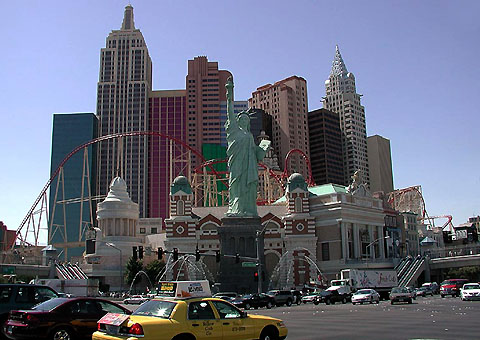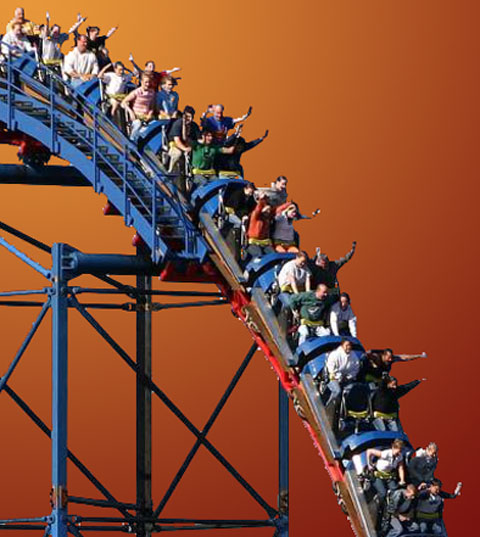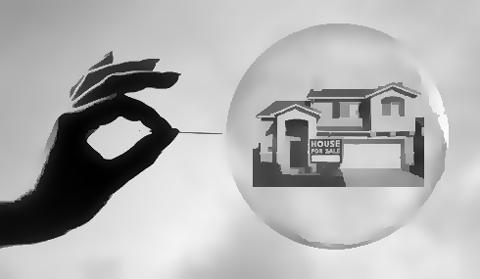by Mike Whitney on 22 February 2007 in www.atlanticfreepress.com
“The US economy is in danger of a recession that will prove unusually long and severe. By any measure it is in far worse shape than in 2001-02 and the unraveling of the housing bubble is clearly at hand. It seems that the continuous buoyancy of the financial markets is again deluding many people about the gravity of the economic situation.” - Dr. Kurt Richebacher
This week’s data on the sagging real estate market leaves no doubt that the housing bubble is quickly crashing to earth and that hard times are on the way. “The slump in home prices from the end of 2005 to the end of 2006 was the biggest year over year drop since the National Association of Realtors started keeping track in 1982.” (New York Times) The Commerce Dept announced that the construction of new homes fell in January by a whopping 14.3%.
Prices fell in half of the nation’s major markets and “existing home sales declined in 40 states”. Arizona, Florida, California, and Virginia have seen precipitous drops in sales. The Commerce Department also reported that “the number of vacant homes increased by 34% in 2006 to 2.1 million at the end of the year, nearly double the long-term vacancy rate.” (Marketwatch)
The bottom line is that inventories are up, sales are down, profits are eroding, and the building industry is facing a steady downturn well into the foreseeable future.
The ripple effects of the housing crash will be felt throughout the overall economy; shrinking GDP, slowing consumer spending and putting more workers in the growing unemployment lines.
Congress is now looking into the shabby lending practices that shoehorned millions of people into homes that they clearly cannot afford. But their efforts will have no affect on the loans that are already in place. $1 trillion in ARMs (Adjustable Rate Mortgages) are due to reset in 2007 which guarantees that millions of over-leveraged homeowners will default on their mortgages putting pressure on the banks and sending the economy into a tailspin. We are at the beginning
of a major shake-up and there’s going to be a lot more blood on the tracks before things settle down.
The banks and mortgage lenders are scrambling for creative ways to keep people in their homes but the subprime market is already teetering and foreclosures are on the rise.
There’s no doubt now, that Fed chairman Alan Greenspan’s plan to pump zillions of dollars into the system via “low interest rates” has created the biggest monster-bubble of all time and set the stage for a deep economic retrenchment.
Greenspan’s inflationary policies were designed to expand the “wealth gap” and create greater economic polarization between the classes. By the time the housing bubble deflates, millions of working class Americans will be left to pay off loans that are considerably higher than the current value of their home. This will inevitably create deeper societal divisions and, very likely, a permanent underclass of mortgage-slaves.
A shrewd economist and student of history like Greenspan knew exactly what the consequences of his low interest rates would be. The trap was set to lure in unsuspecting borrowers who felt they could augment their stagnant wages by joining the housing gold rush. It was a great way to mask a deteriorating economy by expanding personal debt.
The meltdown in housing will soon be felt in the stock market which appears to be lagging the real estate market by about 6 months. Soon, reality will set in on Wall Street just as it has in the housing sector and the “loose money” that Greenspan generated with his mighty printing press will flee to foreign shores.
It looks as though this may already be happening even though the stock market is still flying high. On Friday, the government reported that net capital inflows reversed from the requisite $70 billion to AN OUTFLOW OF $11 BILLION!
The current account deficit (which includes the trade deficit) is running at roughly $800 billion per year, which means that the US must attract about $70 billion per month of foreign investment (US Treasuries or securities) to compensate for America’s extravagant spending. When foreign investment falters, as it did in December, it puts downward pressure on the greenback to make up for the imbalance. Everbank’s Chuck Butler put it like this:
“Not only did the buying stop in December by foreigners in December, but the outflows were huge! Domestic investors increased their buying of long-term overseas securities from $37 billion to a record $46 billion. This is a classic illustration of ‘lack of funding’. So, the question I asked the desk was… ‘Why isn’t the euro skyrocketing?’”
Why, indeed? Why would central banks hold onto their flaccid greenbacks when the foundation which keeps it propped up has been removed?
The answer is complex but, in essence, the rest of the world has loaned the US a pair of crutches to bolster the wobbly dollar while they prepare for the eventual meltdown. China and Japan are currently hold over $1.7 trillion in US currency and US-based assets and can hardly afford to have the ground cut out from below the dollar.
There are, however, limits to the “generosity of strangers” and foreign banks will undoubtedly be pressed to take more extreme measures as it becomes apparent that Team Bush plans to produce as much red ink as humanly possible.
December’s figures indicate that foreign investment is drying up and the world is no longer eager to purchase America’s lavish debt. The only thing the Federal Reserve can do is raise interest rates to attract foreign capital or let the dollar fall in value. The problem, of course, is that if the Fed raises rates, the real estate market will collapse even faster which will strangle consumer spending and shrivel GDP. In other words, we are at the brink
of two separate but related crises; an economic crisis and a currency crisis. That means that the unsuspecting American people are likely to be ground between the two mill-wheels of hyperinflation and shrinking growth.
In real terms, the economy is already in recession. The growth numbers are regularly massaged by the Commerce Department to put a smiley face on an underperforming economy. Industrial output continues to flag (In January it was down by another .5%) while millions good paying factory jobs are being air-mailed to China where labor is a mere fraction of the cost in the USA. Also, automobile inventories are up while factory production is in freefall.
In addition, new jobless claims soared to 357,000 in the week ending February 10. 44,000 more desperate workers have been given their pink slips so they can join the huddled masses in Bush’s Weimar Dystopia.
December’s net capital inflows are a grim snapshot of the looming disaster ahead. As the housing bubble loses steam, maxxed-out American consumers will face increasing job losses and mounting debt. At the same time, foreign investment will move to more promising markets in Asia and Europe causing a steep rise in interest rates. This is bound to be a stunning blow to the banks which are low on reserves ($44 billion) but have generated $4.5 trillion in shaky
mortgage debt in the last 6 years.
It’s all bad news. The global liquidity bubble is limping towards the reef and when it hits it’ll send shock-waves through the global economic system.
Is it any wonder why the foreign central banks are so skittish about dumping the dollar? No one really relishes the idea of a quick slide into a global recession followed by years of agonizing recovery.
Maybe that’s why Secretary of Treasury Hank Paulson has reassembled the Plunge Protection Team and installed a hotline to his Chinese counterpart so he can quickly respond to sudden gyrations in the stock market or a freefalling greenback; two of the calamities he could be facing in the very near future.
Greenspan has successfully piloted the nation into virtual insolvency. In fact, the parallels between our present situation and the period preceding the Great Depression are striking. Just as massive debt was accumulating in the market from the purchase of stocks “on margin”, so too, mortgage debt between 2000 and 2006 soared from $4.8 trillion to $9.5 trillion. In both cases the “wealth effect” spawned a spending spree which looked like
growth but was really the steady, insidious expansion of debt which generated economic activity. In both periods wages were either flat or declining and the gap between rich and working class was growing more extreme by the year. As Paul Alexander Gusmorino said in his article, “Main Causes of the Great Depression”:
"Many factors played a role in bringing about the depression; however, the main cause for the Great Depression was the combination of the greatly unequal distribution of wealth throughout the 1920's, and the extensive stock market speculation that took place during the latter part that same decade".
The same factors are at work today except that the speculation is in real estate rather than stocks. Just as in the 1920’s the equity bubble was not created by wages keeping pace with productivity (the healthy formula for growth) but by the expansion of personal debt. Also, one could buy stocks without the money to purchase them, just as one can buy a $600,000 or $700,000 house today with zero-down and no monthly payment on the principle for years to come.
The current account deficit ($800 billion) could also weigh heavily in any economic shake-up that may be forthcoming. Bob Chapman of The International Forecaster made this shocking calculation about America’s out-of-control trade deficit:
"US debt was up 10.1% to $4.085 trillion and accounts for 58.8% of all the credit issued globally last year. That means the US expanded credit at a much faster rate than the economy grew. This was borrowing to maintain a higher standard of living and attempt to pay for it tomorrow."
Think about that; the US sucked up nearly 60% of ALL GLOBAL CREDIT in one year alone. That is truly astonishing.
There are many similarities between the pre-Depression era and our own. Paul Alexander Gusmorino says:
"The Great Depression was the worst economic slump ever in U.S. history, and one which spread to virtually all of the industrialized world. The depression began in late 1929 and lasted for about a decade....The excessive speculation in the late 1920's kept the stock market artificially high, but eventually lead to large market crashes. These market crashes, combined with the misdistribution of wealth, caused the American economy to capsize.
(The income disparity) between the rich and the middle class grew throughout the 1920's. While the disposable income per capita rose 9% from 1920 to 1929, those with income within the top 1% enjoyed a stupendous 75% increase in per capita disposable income…A major reason for this large and growing gap between the rich and the working-class people was the increased manufacturing output throughout this period. From 1923-1929 the average output per worker increased
32% in manufacturing. During that same period of time average wages for manufacturing jobs increased only 8% (This ultimately causes a decrease in demand and leads to growth in credit spending).
The federal government also contributed to the growing gap between the rich and middle-class. Calvin Coolidge's (pro business) administration passed the Revenue Act of 1926, which reduced federal income and inheritance taxes dramatically…(At the same time) the Supreme Court ruled minimum-wage legislation unconstitutional.
The bottom three quarters of the population had an aggregate income of less than 45% of the combined national income; while the top 25% of the population took in more than 55% of the national income...Between 1925 and 1929 the total credit more than doubled from $1.38 billion to around $3 billion”. (Just like now, the growing wage gap has spawned massive speculative bubbles as well as a steady up-tick in credit spending. Wage stagnation forces workers to seek
other opportunities for getting ahead. When wages fail to keep pace with productivity then demand naturally decreases and business begins to flag. The only way to spur more buying is by easing interest rates or expanding personal credit, and that is when equity bubbles begin to appear. That's what happened to the stock market before 1929 as well as to the real estate market in 2007. The availability of credit has kept the housing market afloat but, ultimately, the
resultwill be the same.
On Monday October 21, 1929, the over-valued stock market began its downward plunge. It managed a brief mid-week comeback, but 7 days later on Black Tuesday it plummeted again; 16 million shares were dumped and there were no buyers.
The game was over.
Confidence evaporated overnight. People stopped buying on credit, the bubble-economy collapsed, and the mighty locomotive for growth, the American consumer, hobbled into the Great Depression. Tariffs were thrown up, foreigners stopped buying American goods; banks closed, business went bust, and unemployment skyrocketed. Tens years later the country was still reeling from the implosion.
Now, 77 years later, Greenspan has led us sheep-like to the same precipice. The economic dilemma we’re facing could have been avoided if the expansion of personal credit had been curtailed by prudent monetary policy at the Federal Reserve and if wealth was more evenly distributed as it was in the ‘60s and ‘70s. But that’s not the case; so we’re headed for hard times.
|


